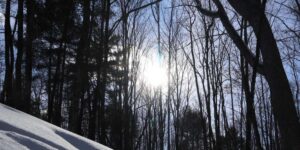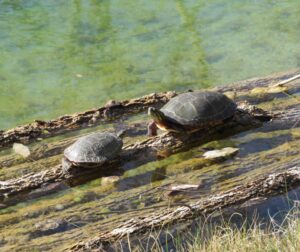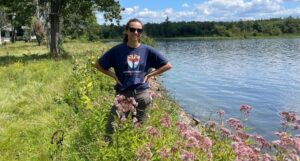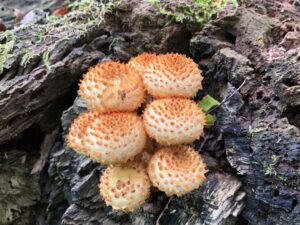By Joseph Gentile, KLT Volunteer
Wildflowers make up a significant proportion of the local terrestrial food web. They are species that have evolved to withstand the harsh Ontarian climate, with no artificial rendering from humans.
Because of these factors, wildflowers are key to sustaining life in fragile ecosystems and are an indication of stellar biodiversity. To further this, several ephemeral wildflower species are relatively short-lived, meaning they are in bloom for a short duration — usually spanning only a couple of weeks — while deciduous foliage is still developing, and the wildflowers can harness the sun’s energy that freely reaches them!
Ephemeral wildflowers exist in dense woodlands and the flowers do not gain great vertical height. The success rate of the growth of these species is directly dependent on the health of the understory ecosystem in which they inhabit.
Kawartha Land Trust’s Jefferey-Cowan Forest Preserve is located along the northern shoreline of Ston(e)y Lake, in Woodview. This nature reserve’s mature mixed-wood forest growth provides a fantastic understory ecosystem (with many nutrient-rich organic crevices and deciduous leaf litter) in which many Ontario wildflower species can thrive.
Here are some common wildflower species found within the Kawarthas:
Trout Lily (Erythronium Americanum): This vibrant wildflower is one of the very first to bloom in the spring. Its distinctive features include three bright-yellow flower petals (that face down), and three bright-yellow sepals that are sharply pointed and bend in a backward succession, toward the main stem.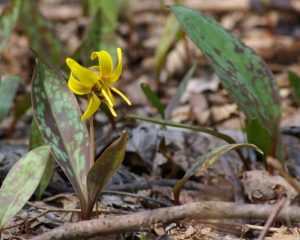
Yellow Lady’s Slipper (Cypripedium Parviflorum): Lady’s Slippers are fascinating, fragile species that look like none other! A single stem containing an alternate arrangement of ovate leaves gives way to a breathtaking irregular yellow flower (resembling a slipper-like formation) and several irregular-shaped petals behind it.
There are several species of Lady’s Slippers that, due to the brief nature of this article, will not be mentioned in this article. It is important to note that some species are endangered in Ontario — Lady’s Slippers are unique to their habitat and require very specific growing environments.

Dutchman’s Breeches (Dicentra Cucullaria): Known for their unusual flower shape and round-lobed leaves, Dutchman’s Breeches are a common ephemeral species in the Kawarthas. They prefer moist, moderately shaded environments and grow only a few inches in height.
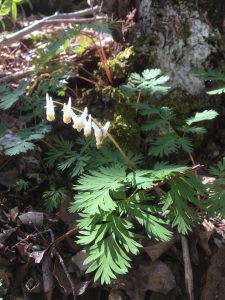
Sharp-Lobed Hepatica (Anemone Acutiloba): This beautiful, dainty flower contains six white petals that are rounded at the apex. The main way to distinguish them from their co-related species, Round-lobed Hepatica, is through their sharply-lobed leaves.
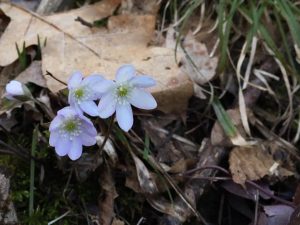
Round-lobed Hepatica (Anemone Americana): Visually, Round-lobed Hepatica are very similar to Sharp-lobed Hepatica. This species contains six petals in colours that ranges from white to violet or pink, with a noticeable point at the apex. Leaves consist of three rounded lobes.

White Trillium (Trillium Grandiflorum): White Trilliums are the most iconic of all Ontario wildflowers! They contain three white flower petals above three whorled leaves and grow in shaded pockets of dense understory. With age, these ephemerals gain an off-white/pink hue.
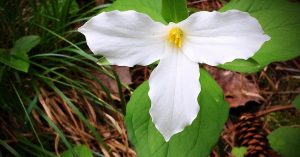
Mayapple (Podophyllum Peltatum): Like the Trout Lily, Mayapples are some of the very first wildflowers to bloom in Ontario. Mayapples are characterized by their noticeably large six-lobed leaves (ending in bristled tips), containing deep sinuses/cuts.
Their small, white flowers are dainty and very delicate. Fun fact: only the ripened fruit from Mayapples can be consumed; non-ripe fruit (soft and green in colour) are poisonous.
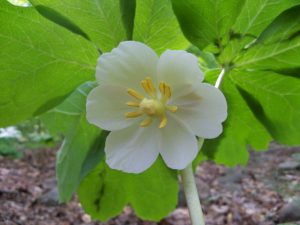
Blue Cohosh (Caulophyllum Giganteum): New growth is characterized by very dark, purple leaves, stems and flowers, which are sometimes hard to see against the forest floor.
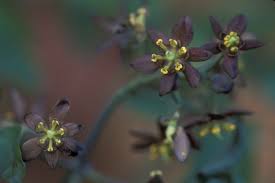
Fostering awareness of these fragile woodland wildflowers has proven to be beneficial to the long-term sustainability of our mixed-wood ecosystems. Kawartha Land Trust is proud to conserve several stances of these forests, protecting a number of native wildflower species.
KLT’s Stony Lake Trail network is a great place to visit to see spring ephemerals. Which wildflowers will you be able to spot on your walk?
Posted April 31, 2021.



